

![]()
THOMAS BEWICK
1753-1828
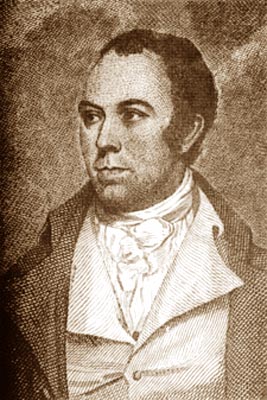
A portrait of Thomas Bewick as a young man.
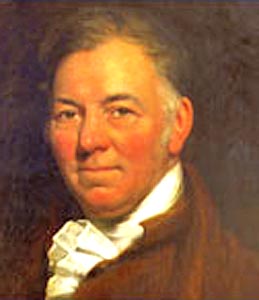 Left, a portrait of Thomas Bewick in middle years.
Left, a portrait of Thomas Bewick in middle years.
Thomas Bewick was born at Cherryburn House, in the village of Mickley, Northumberland, England, in August of 1753. His father, John, was a tenant on the eight-acre farm and rented the adjacent colliery (coal mine). Thomas was the eldest of eight children. Expected to help with the farm and mining chores, Thomas was often delinquent, preferring to fish and roam the countryside observing birds, flowers, and animals. This activity proved to have a great influent on his work.
Bewick showed talent for drawing at a young age, and at the age of fourteen he was apprenticed to an engraver, Ralph Beilby in nearby Newcastle upon Tyne. His apprenticeship lasted the usual seven years, during which time he learned the skills to excel in the engraving business. Beilby, however, recognised Bewick's talent for woodcut engraving, and set him to work on a number of book illustrations, including children's books and fables.
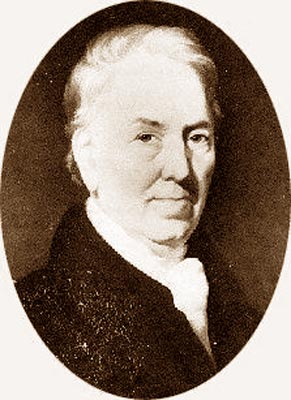 Right, a portrait of Bewick later in life.
Right, a portrait of Bewick later in life.
When Bewick completed his apprenticeship, he set out on foot to explore Scotland, and then went to London to try his luck. But he disliked the city and soon returned to Newcastle to resume his association with Ralph Beilby. In 1777, Bewick became a partner in Beilby's workshop. In 1790, A General History of Quadrupeds was published. The intent was to encourage the youth of the day to study natural history, and the book was very well received. The accuracy in which the animals were portrayed was refreshing. Bewick illustrated the book with wood engravings. There are 200 illustrations in the first edition. By the second edition he had produced 212 illustrations, and by the fourth edition, which appeared in 1800, the number of illustrations had risen to 224. The Shepherd's Dog and The Cur Dog appear in all six editions of the book.
One should not think that Bewick produced all his illustrations from life. Many were copied from other books of the time, most notibly the nine-volume edition of Buffon's Histoire Naturelle (1781-1785). But Bewick's skill and the quality of his engravings were unparalleled for the time, and indeed, he advanced the field of wood engraving. Poets of the day, Wordsworth and Bronte among them, extolled Bewick's genius. He is best remembered for his two works of Natural History: A History of British Birds and A General History of Quadrupeds. It is the latter that we are primarily interested in, for it is there that we find the shepherd's dog.
Regarding the text of A General History of Quadrupeds, there is some disagreement as to how much was written by Bewick, and how much by Ralph Beilby, and there is no explanation in the book. To us it is immaterial, because the text and illustrations are equally important in giving us a picture of the Shepherd's Dog and the related type, the Cur Dog, as they appeared in the 18th century. As with the Caius quote of 200 years before, we can see our dogs of today in these descriptions, both in looks and manner of working. Of these dogs, Quadrupeds says:
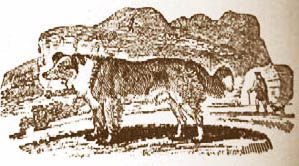
THE SHEPHERD'S DOG
This useful animal, ever faithful to his charge, reigns at the head of the flock; where it is better heard, and more attended to, than even the voice of the shepherd. Safety, order, discipline, are the fruits of his vigilance and activity.
In those large tracts of land which, in many parts of our island, are solely appropriated to the feeding of Sheep and other cattle, this sagacious animal is of the utmost importance. Immense flocks may be seen continually ranging over those extensive wilds, as far as the eye can reach, seemingly without control: Their only guide is the shepherd, attended by his faithful Dog, the constant companion of his toils: It receives his commands, and is always prompt to execute them; it is the watchful guardian of his flock, prevents them from straggling, keeps them together, and conducts them from one part of their pasture to another; it will not suffer any strangers to mix with them, but carefully keeps off every intruder. In driving a number of Sheep to any distant part, a well-trained Dog never fails to confine them to the road, watches every avenue that leads from it; where he takes his stand, threatening every delinquent: He pursues stragglers, if any should escape; and forces them into order, without doing them the least injury. If the herdsman is obliged to leave them, he depends upon his Dog to keep the flock together; and as soon as he hears the well-known signal, this faithful creature conducts them to his master, though at a considerable distance. . . .
This breed of Dogs, at present, appears to be preserved, in the greatest purity, in the northern parts of Scotland; where its aid is highly necessary in managing the numerous herds of Sheep bred in those extensive wilds.
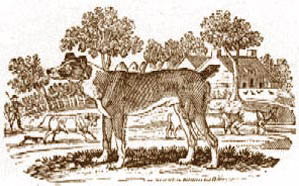
THE CUR DOG
The Cur Dog is a trusty and useful servant to the farmer and grazier; and although it is not taken notice of by naturalists as a distict race, yet it is now so generally used, especially in the North of England, and such great attentin is paid in breeding it, that we cannot help considering it as a permanent kind. In the North of England, this and the [Shepherd's Dog] are called Coally Dogs.
They are chiefly employed in driving cattle; in which way they are extremely useful. They are larger, stronger, and fiercer than the Shepherd's Dog; and their hair is smoother and shorter. They are mostly of a black and white colour; their ears are half-pricked; and many of them are whelped with short tails, which seem as if they had been cut; these are called Self-tailed Dogs. They bite very keenly; and as they always make their attack at the heels, the cattle have no defence against them...
For more information on Thomas Bewick, please go to The Bewick Society.
Copyright 2008 by Carole L. Presberg
THE OTHER WEB PAGES WE MAINTAIN
These web pages are copyright ©2013
and maintained by webmeistress Carole Presberg
with technical help from webwizard David Presberg
ALL RIGHTS RESERVED
If you are interested in using ANY material on this website, you MUST first ask for permission.
You may email us at carole@woolgather.org.